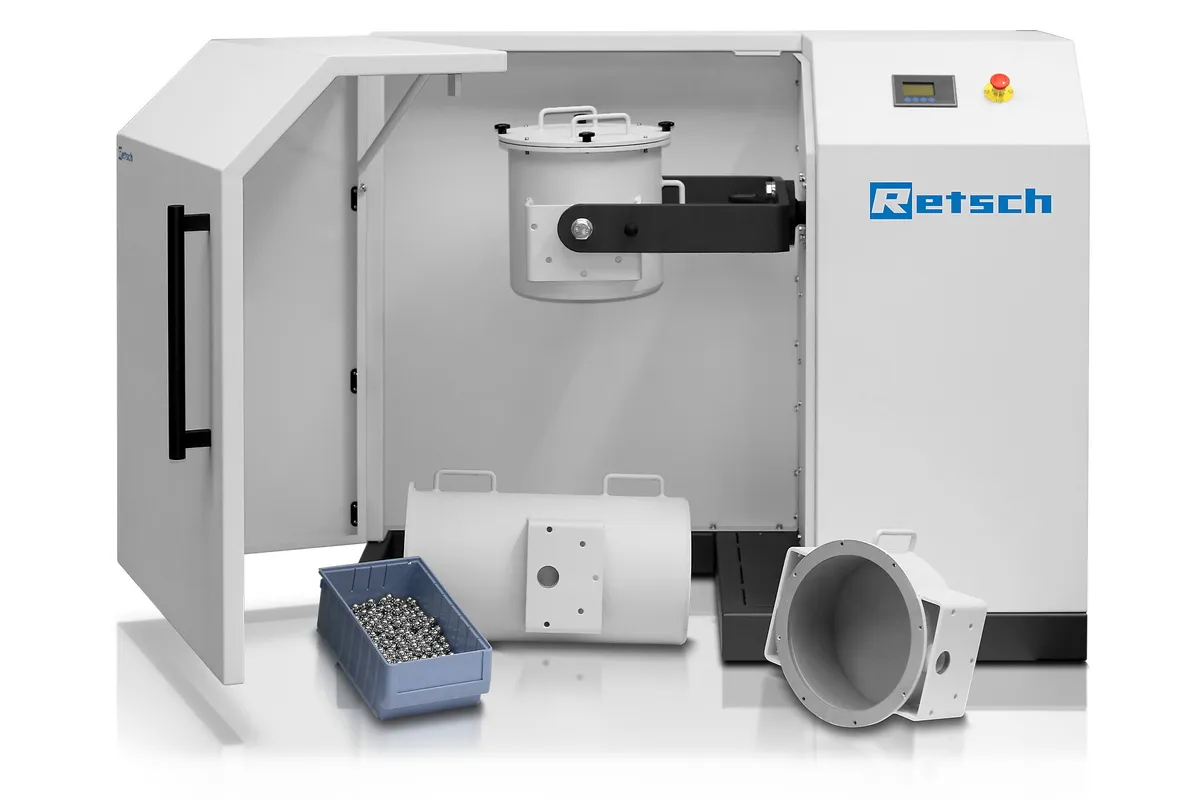

Drum mill TM 300 for laboratory grinding and Bond index determination
Артикул: TM 300
The drum mill consists of a gear motor mounted on a solid steel frame complete with outlet funnel and a set of separation screens plus sample collector. The TM 300 features a yoke and locking mechanism for easy access to the sample. The drum cover is easily removed for cleaning thanks to a quick release locking mechanism.
Adjustment of grinding parameters:
Parameters like grinding time or start and stop are set conveniently via the display. The following factors have an influence on the final particle size: Sample characteristics, maximum feed size and capacity. We will gladly support you in working out the most suitable configuration for your specific application.
APPLICATION EXAMPLES
alloys, bentonite, bones, carbon fibres, catalysts, cellulose, cement clinker, ceramics, charcoal, chemical products, clay minerals, coal, coke, compost, concrete, electronic scrap, fibres, glass, gypsum, hair, hydroxyapatite, iron ore, kaolin, limestone, metal oxides, minerals, ores, paints and lacquers, paper, pigments, plant materials, polymers, quartz, seeds, semi-precious stones, sewage sludge, slag, soils, tissue, tobacco, waste samples, wood, ...
PRODUCT ADVANTAGES
- powerful and quick grinding of large quantities
- suitable for dry and wet grinding
- variable speed, reproducible results
- suitable for long-term operations
- ball mill and rod mill modules available
- easy tilt to empty the grinding jar
- solid steel frame
- removable sample collector
- convenient parameter setting via display
- standard sizes of grinding drums from 5 to 43.4 l
- separation grid to separate sample from grinding balls (only for Ball Mill)
- funnel with handles
- guide rail allows for ergonomic removal of drum
- grinding jar with gasket for lossfree operation
- solid noise-protection hood
- emergency switch
FEATURES
| Applications | pulverizing, mixing
used as Bond Index Tester: quantification of grindability of ores and minerals |
| Field of application | agriculture, biology, chemistry, construction materials, engineering / electronics, environment / recycling, geology / metallurgy, glass / ceramics, medicine / pharmaceuticals |
| Feed material | soft, hard, brittle, fibrous - dry or wet |
| Size reduction principle | friction |
| Material feed size* | < 20 mm
used as Bond Index Tester: < 3.35 mm with ball module / 12.50 mm with rod module |
| Final fineness* | < 20 µm
used as Bond Index Tester: < 100 µm with ball module / 2,100 µm with rod module |
| Batch size / feed quantity* | mminimum 1 l / maximum 20 l
used as Bond Index Tester: min. 15 kg with ball module / min. 20 kg with rod module |
| Rotation speed | 1 - 80 min-1
used as Bond Index Tester: 70 min-1 with ball module / 46 min-1 with rod module |
| No. of grinding stations | 1 |
| Material of grinding tools | hardened steel, stainless steel
used as Bond Index Tester: hardened steel |
| Grinding drum sizes | 5 l / 10 l / 21.7 l / 43.3 l
used as Bond Index Tester: 21.7 l with ball module / 43.3 l with rod module |
| Setting of grinding time | digital |
| Drive | 3-phase asynchronous motor with frequency converter |
| Drive power | 0.75 kW |
| Electrical supply data | different voltages |
| Power connection | 1-phase |
| Protection code | IP 55 |
| Power consumption | ~ 750 W (VA) |
| W x H x D closed | 1500 x 1200 x 700 mm |
| Net weight | ~ 306 kg |
| Standards | CE |
FUNCTIONAL PRINCIPLE
In a drum mill the sample (usually pre-crushed material) is placed inside the drum with the grinding balls and subjected to external forces.
The Ball Mill is used for fine grinding of solid matter by impact and friction in dry condition. The drum, which contains the sample and grinding balls, rotates around a horizontal axis. Whereas particles break more easily when larger grinding ball diameters are used, smaller diameters lead to a substantially higher final fineness.
The ball and the rod mill basically have the same concept comprising either a 12''x12'' jar with grinding balls or a 12''x24'' jar with grinding rods.
The jar is attached to a rotating yoke which is driven by a motor and can be placed in three different positions: Upwards for loading, horizontal for grinding, downwards for discharging.
To carry out the Bond Index test the pre-defined number of grinding balls or grinding rods is required. The electronic control integrated in the drive is equipped with an overload protection and permits and controls different speeds.
During the grinding process the difference in speeds between the balls / rods and grinding jar produces an interaction between frictional and impact forces, which releases the required comminution energy. The interplay between these forces produces a very effective degree of size reduction.

